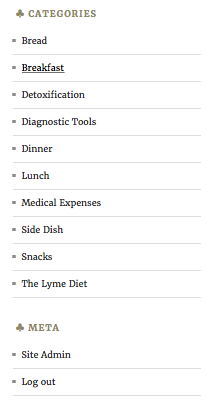Treating Lyme disease is like a trilogy. In a three-pronged approach to get better you have to incorporate 1) antibiotics (or a herbal protocol) 2) supplementation and detoxification (preferably coordinated with a naturopath) and diet.
Today, I’m focusing on the Lyme diet.
At a recent York North Lyme Support group meeting in Markham, Kevin Sherriff was the guest speaker. He was there to talk about Lyme Savers – a foundation he started to raise money to provide bursaries to those with Lyme disease that either can’t afford treatment or are financially strapped by the burden of paying for treatment.
After the discussion, Kevin briefly talked about his own journey with Lyme disease and told the audience that he has been extremely strict with the Lyme diet. After two years in treatment, he still avoids sugar and yeast and sticks to the Lyme diet religiously. He went on to say that he follows a Paleo diet and has used many of the recipes in Practical Paleo by Diane Sanfilippo.
Paleo is a way of eating that harkens back to just the basics: protein – such as beef, chicken and fish, fruits and vegetables and nuts and seeds. One thing to keep in mind when using recipes from Paleo sites or books is that they are NOT written with the Lyme diet in mind, so they may not be conducive to all foods we should ideally avoid eating. You may find instances where recipes may include sugar or white vinegar etc.
Early in my own Lyme treatment, I used recipes from a book called Make it Paleo by Bill Staley and Hayley Mason. They’ve since written two other books and a selection of their recipes can be found at: http://www.primalpalate.com/paleo-recipes/#
I went to Diane Sanfilippo’s site and found a section of Paleo recipes divided into categories: breakfast & eggs, beef/pork/lamb, poultry, fish, soups and salad, sides, snacks, desserts, nut-free desserts, and sauces/dressings & basics. Here is the link to Diane’s recipes: http://balancedbites.com/recipes
Take Paleo recipes with a ‘grain of salt’ and recognize that you will need to adapt many of them and/or avoid some of them altogether. As an alternative to Paleo, you can also check out the recipes on my site which are already Lyme-friendly. I started ‘Squeeze of Lyme’ for Lyme sufferers, like myself, who struggle with the Lyme diet.
The goal of the Lyme diet is to avoid any food that might cause inflammation. Your body is busy enough trying to fight off infection – it doesn’t need the added stress of fighting off inflammation from the food you put into it. But it’s a hard and very restrictive diet to follow – especially the gluten free aspects.
Ironically, when I was first diagnosed with Lyme disease, gluten free eating was the easiest for me because my husband was diagnosed with Celiac disease six years ago; our household has been gluten-free ever since. What started out as a complete elimination of gluten, so I wouldn’t cross-contaminate my husband, turned out to be a blessing in disguise. The following link is a great reference for hidden sources of gluten: http://www.balancedbites.com/PDFs/BalancedBites_Gluten.pdf and if you have any further questions about gluten-free living, feel free to ask; I’ve learned a lot over the past six years!
The recipes on Squeeze of Lyme are already adapted to follow the ‘rules’ of the Lyme diet (in any cases where there are exceptions to the ‘rules’, I always note them in the recipe). Here’s a brief list of those rules:
- No gluten. Gluten can be hidden in places you would never expect. For instance: nuts (sometimes wheat is used to coat them to prevent sticking), prescription medication/supplements, caramel colour, soy sauce, spices, pasta sauces etc. Always try to purchase products that are marked ‘gluten free’ and manufactured in a dedicated facility. See the link above for hidden sources of gluten to watch for.
- No yeast (eliminate commercially baked breads and mushrooms).
- No sugar. The only acceptable substitute. according to my LLMD, is stevia which is a natural product.
- No caffeine. Even decaf coffee can cause inflammation from the process used to decaffeinate the beans. I use an herbal coffee substitute called ‘Dandy Blend’ made with Dandelion (http://www.dandyblend.com/about.asp).
- No vinegar. Foods that contain vinegar include vanilla extract, olives, ketchup, mustard, salad dressings, BBQ sauces etc. The only exception is apple cider vinegar made with the Mother.
- No alcohol.
- No genetically modified (GMO) products (i.e. corn).
- No dairy – with the exception of goat milk products.
- No fermented products (i.e. soy sauce, tofu).
- No dried fruits.
- No white potatoes, corn, white rice.
- No peanuts.
In addition to avoiding foods from the list above, its prudent for Lyme sufferers to buy organic produce, where possible. Pesticides are just another source of inflammation that’s important to avoid. The Environmental Working Group (EWG) posts and updates their ‘Dirty Dozen Plus’ and ‘Clean Fifteen’ lists so consumers are aware of what produce is safe and what should be avoided. You can link directly to their lists here: http://www.ewg.org/foodnews/
For recipes I’ve developed for the Lyme diet at various stages of my illness, refer to the home page where categories are organized as follows:

I would welcome any original Lyme diet recipes that you’d like to share with other Lymies, so please send them my way 🙂 I’ll test them out and post them with full credit.
